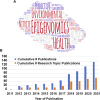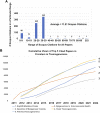10 Years of Toxicogenomics section in Frontiers in Genetics: Past discoveries and Future Perspectives
- PMID: 36171875
- PMCID: PMC9510767
- DOI: 10.3389/fgene.2022.979761
10 Years of Toxicogenomics section in Frontiers in Genetics: Past discoveries and Future Perspectives
Erratum in
-
Erratum: 10 Years of Toxicogenomics section in Frontiers in Genetics: Past discoveries and Future Perspectives.Front Genet. 2023 May 30;14:1213706. doi: 10.3389/fgene.2023.1213706. eCollection 2023. Front Genet. 2023. PMID: 37323677 Free PMC article.
Abstract
The Frontiers Media family has over 200 journals, which are each headed by usually one Field Chief Editor, and several thousand specialty sections, which are each headed by one or more Specialty Chief Editors. The year 2021 was the 10th anniversary of the founding of the Frontiers in Genetics journal and the Frontiers in Toxicogenomics specialty section of this journal. In 2021, we also announce one of the newest of the Frontiers journals-Frontiers in Toxicology which is part of the Frontiers Media family of journals but independent of Frontiers in Genetics. Dr. Ruden is the founding, and currently sole, Specialty Chief Editor of Frontiers in Toxicogenomics and one of 9 Specialty Chief Editors of Frontiers in Toxicology. As of 2021, Frontiers in Toxicogenomics has published over 138 articles and has over 370 Editors including 90 Associate Editors and 280 Review Editors. The Frontiers in Genetics impact factor was initially approximately 2.5 when it was first listed in PubMed in 2015 and has risen steadily to its current value of 4.8, which is typical for the majority of the over 200 Frontiers journals that have established impact factors. In this overview of the first decade of Frontiers in Toxicogenomics, we discuss the top 5 articles with the highest Scopus citations, which were all written in the first few years of the journal. The article with the highest number of citations, with 353 Scopus over 600 Google Scholar citations, and the highest average number of citations (67) that steadily increased from 10 citations in 2013 to 119 citations in 2021, was written in 2012 by Dr. Ruden's laboratory and titled, "Using Drosophila melanogaster as a model for genotoxic chemical mutational studies with a new program, SnpSift." The five most influential authors who published in the journal in the past 10 years based on Scopus citations of a particular paper are Dr. Ruden's laboratory, with 353 Scopus citations for the SnpSift paper mentioned above; Drs. Brock Christensen and Carmen J. Marsit, with 86 Scopus citations for their review, "Epigenomics in environmental health"; Dr. Michael Aschner and colleagues, with 61 Scopus citations for their paper "Genetic factors and manganese-induced neurotoxicity"; and Dr. Sandra C. dos Santos and colleagues, with 59 Scopus citations for their paper, "Yeast toxicogenomics: genome-wide responses to chemical stresses with impact in environmental health, pharmacology, and biotechnology." While the top 5 papers were published in the early years of the journal, we will also discuss a more recent article published in 2018 on a comparison of RNA-seq and microarray methods by Dr. Michael Liguori's laboratory, "Comparison of RNA-Seq and Microarray Gene Expression Platforms for the Toxicogenomic Evaluation of Liver From Short-Term Rat Toxicity Studies," that far exceeds the number of downloads and views of all the other articles published in the first 10 years of the journal and will likely be a top cited paper in the second decade highlights of this journal. Finally, we discuss where the Frontiers in Toxicogenomics specialty journal and the Frontiers in Toxicology journal will go to advance the field of toxicogenomics, and more generally, toxicology, in the future.
Keywords: environmental health; epigenomics; genomics; toxicogenomics; toxicology; transcriptomics.
Copyright © 2022 Ruden.
Conflict of interest statement
The author declares that the research was conducted in the absence of any commercial or financial relationships that could be construed as a potential conflict of interest.
Figures


References
Publication types
Grants and funding
LinkOut - more resources
Full Text Sources
Research Materials
Miscellaneous

